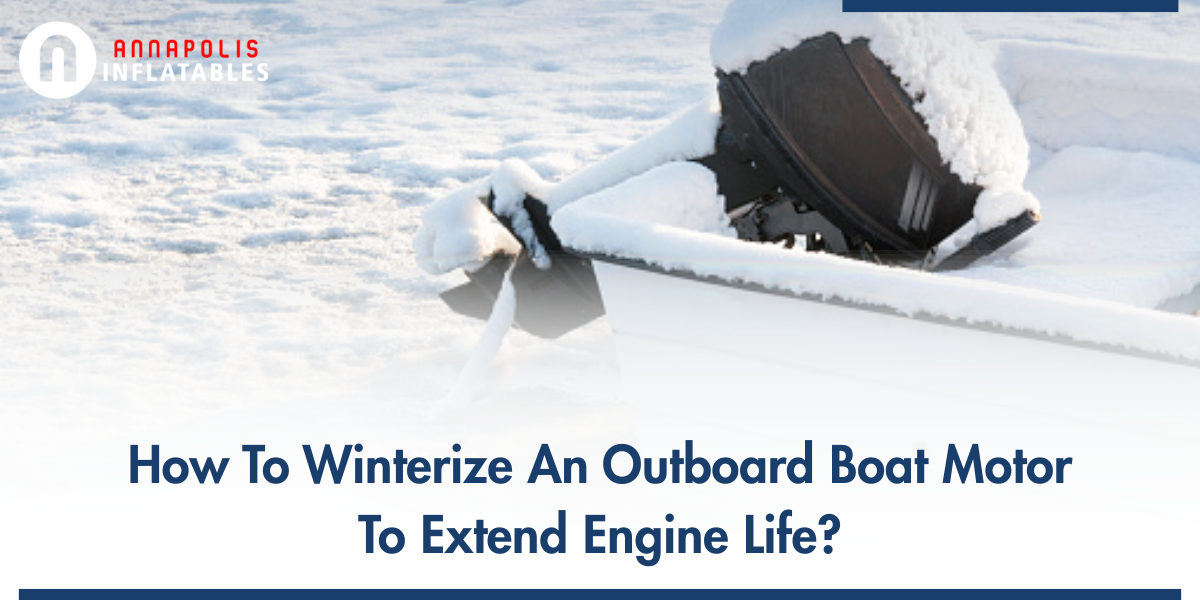
How to Winterize an Outboard Boat Motor for Long-Term Protection
Table of Contents
As winter approaches and temperatures drop, your inflatable boat, especially its motor, needs special attention. Failing to winterize can lead to issues like rust inside the engine, clogged fuel systems, battery problems, and cracked components caused by freezing conditions. Winterizing is more than routine maintenance; it’s a crucial step in safeguarding performance and engine life.
Guide on How to Winterize a Boat Motor
Identify Your Motor Type
Most inflatable boats use small, portable outboards, but winterization steps differ slightly based on the motor:
- 2-Stroke vs. 4-Stroke: Two-stroke engines mix oil with fuel, while four-stroke engines need oil changes.
- Gas vs. Electric: Electric outboards (e.g., Torqeedo) require battery maintenance but no fuel system care.
What Tools and Supplies are Required to Winterize Boat Motor
Gather these items before starting:
- Flushing muffs or a freshwater flush kit
- Marine fuel stabilizer
- Fogging oil for gasoline engines
- Engine and gear oil
- Rust-inhibitor spray
- Marine grease and grease gun
- Battery charger or maintainer
- Soft cloths, brushes, torque wrenches
- Dielectric grease (for electric terminals)

How To Winterize A Two Stroke Boat Motor
- Flush the Cooling System: Use flushing muffs and a hose to circulate fresh water for 5–10 minutes. Rinse with vinegar if used in saltwater.
- Treat the Fuel: Add stabilizer, run the engine to distribute, then drain the carburetor (especially for Yamaha and Tohatsu) to prevent gumming.
- Fog the Engine: Spray fogging oil into the air intake while running until it stalls, or spray directly into spark plug holes.
- Replace Gear Oil: Drain and refill lower gear oil, checking for water contamination.
- Spark Plug & Battery Care: Inspect, clean, or replace spark plugs. Store the battery in a cool, dry area using a trickle charger.
- Lubricate and Protect: Apply marine grease to moving parts and rust inhibitor to exposed hardware of your two-stroke boat motor.
How To Winterize A Four Stroke Boat Motor
- Flush the Cooling System: Run freshwater for 5–10 minutes to remove debris.
- Treat the Fuel: Add stabilizer and run. For EFI models, draining the system is recommended for long-term storage.
- Fog the Engine: Spray fogging oil into the intake while idling, or apply directly into cylinders. Fogging is vital if you’re not changing the oil immediately.
- Change Engine & Gear Oil: Replace old engine and gear oil, and change the filter.
- Spark Plug & Battery Care: Check and replace spark plugs as needed. Store and maintain the battery properly.
- Lubricate and Protect: Grease all fittings and spray rust inhibitor on exposed metal.

How to Winterize Electric Outboards (e.g., Torqeedo)
- Charge the battery to 50–60% for storage longevity.
- Disconnect and remove the battery; store indoors in a dry, room-temperature spot (15–24°C/60–75°F).
- Never charge or store batteries in freezing or humid conditions.
- Clean the motor with a soft cloth and ensure all surfaces are dry.
- Apply dielectric grease to all electric terminals.
- Check for and install firmware updates before storage.
Brand-Specific Recommendations to Winterize Boat Motor
- Mercury: Use Quicksilver oils for warranty; check for corrosion.
- Tohatsu: Always drain the carburetor bowl; use Tohatsu fogging oil and lube.
- Yamaha: Use a fuel stabilizer and Yamaha Ring Free Plus to prevent deposits.
- Torqeedo: Store batteries at 10–30°C and update firmware as needed.
-
Suzuki:
Grease steering and shift linkages, and check hoses for cracks.
Winterize your boat professionally with Annapolis Inflatables now! Our professional services add an extra layer of care. Our support includes:
- Secure outdoor storage (billed monthly by vessel size)
- Complete winterization
- Professional cleaning and detailing
- Bottom painting
- Shrink wrap protection
- General repairs and routine maintenance
- Specialized dinghy storage
These services cover everything from large fiberglass boats and rigid inflatables to tenders, small boats, and dinghies. With the right upkeep, your boat stays protected off-season and ready for the water when you are.
Common Mistakes to Avoid
- Leaving untreated fuel in the tank
- Storing batteries in freezing or damp places
- Neglecting the gear oil change
- Not flushing out saltwater
- Using automotive rather than marine-grade lubricants
Conclusion
Proper winterization is crucial for protecting your outboard motor, whether two-stroke, four-stroke, or electric. Taking time to prepare your motor now prevents corrosion, fuel issues, and expensive spring repairs, ensuring a smooth start to the next boating season.
For expert help and specialized winterization services, visit AnnapolisInflatables.net and keep your boat ready for the water year after year.
FAQs
Yes. Most small outboards can be prepared at home with basic tools and by carefully following the steps for your specific motor type.
Yes. While they don't need fuel care, battery and electrical maintenance are essential.
The risks include clogged fuel systems, rust, battery failure, and cracked components, leading to costly repairs.
Begin when you won’t use your boat for 30 days or longer, and before freezing temperatures set in. Early preparation ensures you won’t skip important steps.

